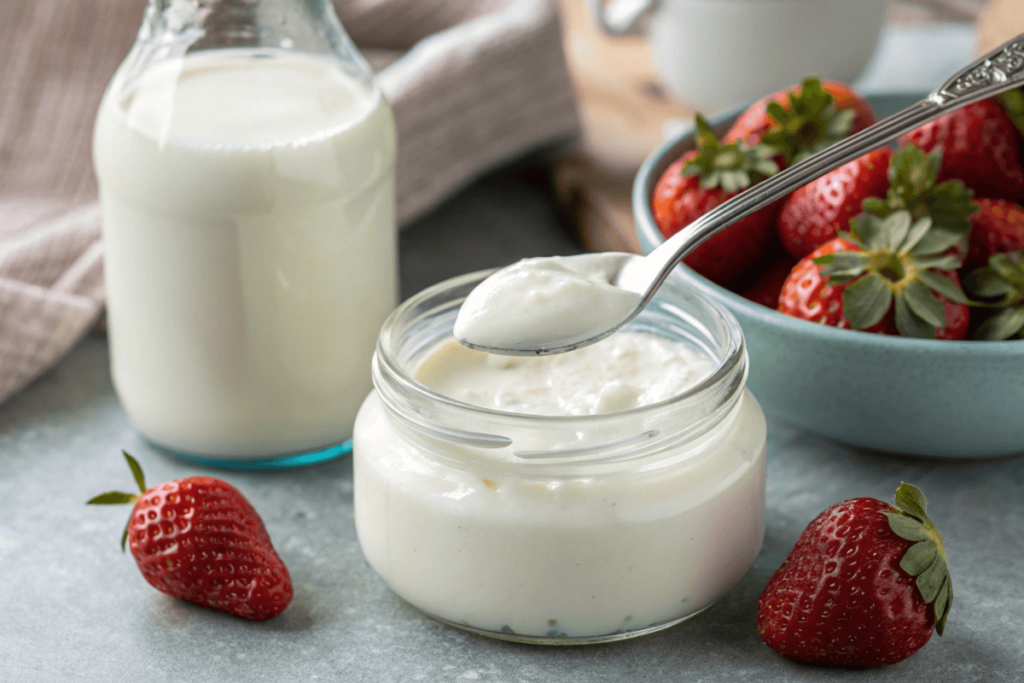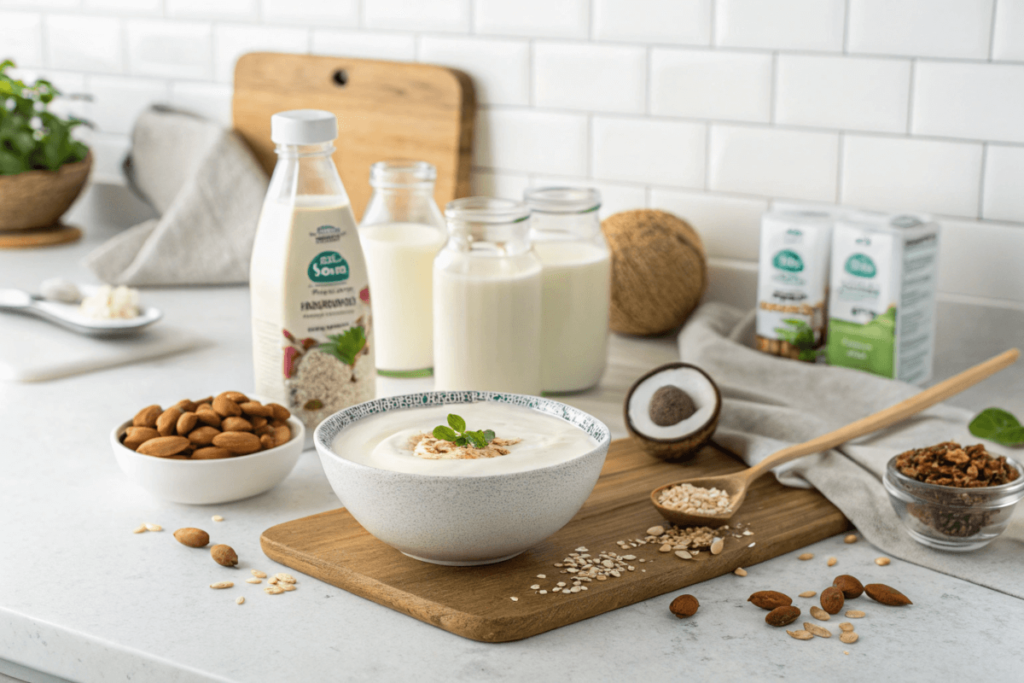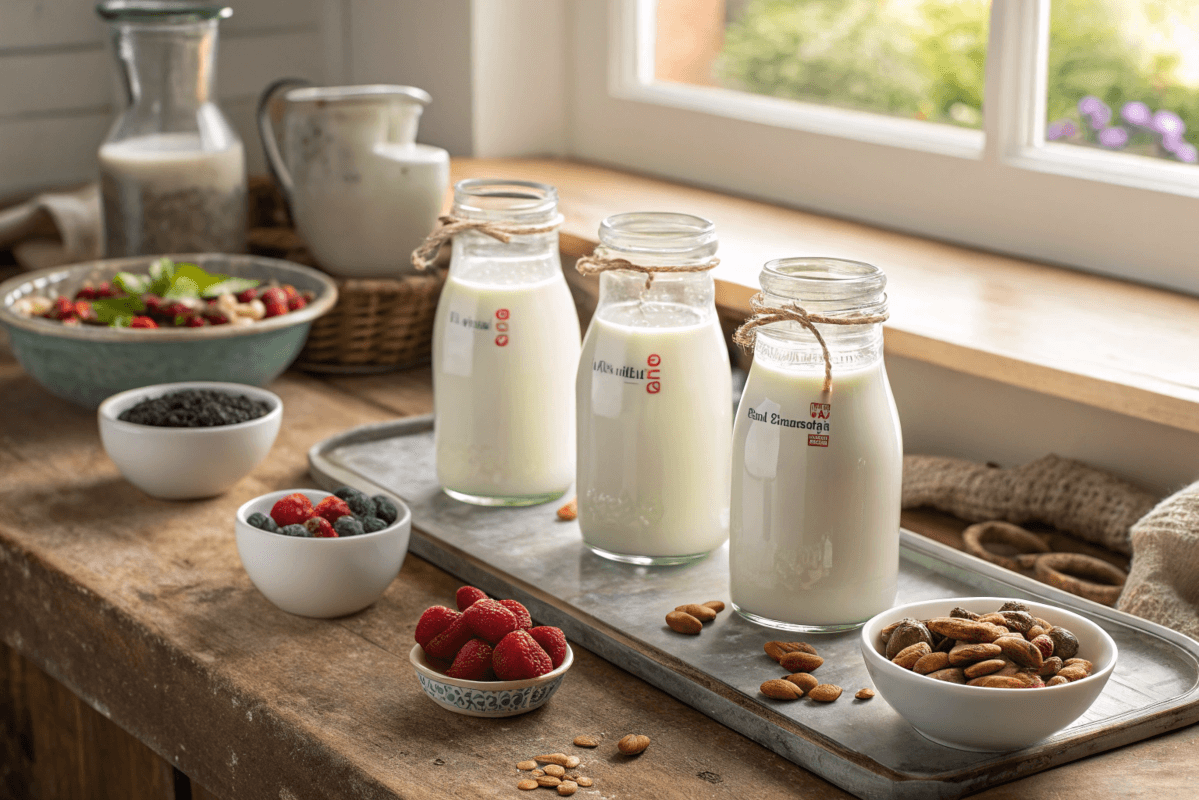When it comes to crafting the perfect homemade yogurt, the type of milk you choose can make all the difference. Whether you’re aiming for a rich, creamy texture or a lighter, healthier option, milk is the cornerstone of the process. In this guide, we’ll dive deep into the question: What kind of milk is best for homemade yogurt? We’ll explore various milk types, their preparation, and how they affect your yogurt’s flavor, consistency, and overall quality. From traditional cow’s milk to trendy non-dairy alternatives, this article covers it all.
Let’s kick things off by discussing the growing appeal of homemade yogurt and why the choice of milk matters.
Introduction to Homemade Yogurt
The Popularity of Yogurt-Making at Home
Homemade yogurt has gained immense popularity in recent years, and for good reasons. With just a few simple ingredients and easy techniques, it’s no surprise that more people are ditching store-bought varieties. Not only does it save money, but it also allows you to control the quality, flavor, and nutritional value of your yogurt. Moreover, making yogurt at home means you no longer have to worry about hidden sugars or preservatives, which are often present in commercial options.
Basic Ingredients and Tools Required for Homemade Yogurt
The basics of homemade yogurt are straightforward, and they require very little effort. All you need is milk—the star of the show—and an active bacterial culture, often referred to as a starter. Additionally, having a few simple tools, like a saucepan, thermometer, and a container for incubation, can make the process even smoother. Most importantly, patience is key—it’s a process that rewards your time and care. Therefore, with the right ingredients and tools, making yogurt at home can be a fulfilling and enjoyable experience.
Why the Choice of Milk Matters
Not all milk is created equal when it comes to yogurt-making. The milk’s fat content, protein levels, and pasteurization type significantly influence the final product’s taste and texture. Whether you prefer thick and creamy or light and tangy yogurt, understanding milk’s role is key. So, choosing the right milk is the first step toward yogurt perfection.
Stay tuned as we explore the types of milk you can use and how they impact your homemade yogurt-making journey!
Types of Milk for Yogurt
Cow’s Milk: Skim, 2%, and Whole Options
Cow’s milk is the most popular choice for making yogurt, and for good reason. It’s rich in protein and lactose, which are crucial for fermentation. Whether you use skim, 2%, or whole milk, the results will vary in texture and flavor. Whole milk produces a luxuriously creamy yogurt with a rich taste, while skim milk yields a lighter, tangier result. Opt for 2% milk if you want a middle ground between the two.
Each option has its pros and cons. Whole milk is ideal for those craving indulgence, while skim milk suits health-conscious individuals. No matter your choice, cow’s milk remains a reliable option for yogurt lovers.
Alternative Milks: Goat’s Milk and Sheep’s Milk
If you’re looking to switch things up, goat’s and sheep’s milk are excellent alternatives. Goat’s milk has a slightly tangy flavor, which translates beautifully into yogurt. It also has smaller fat globules, making the final product naturally smoother. Sheep’s milk, on the other hand, boasts a higher fat and protein content, leading to a thicker, creamier yogurt.
These alternatives can provide a unique twist to your yogurt-making experience. Plus, they’re great options for those sensitive to cow’s milk.
Non-Dairy Milk: Almond, Soy, and Coconut Milk
For those avoiding dairy, non-dairy milks like almond, soy, and coconut are fantastic choices. However, their lower protein content can make the fermentation process trickier. To counter this, you may need to add thickeners like agar-agar or tapioca starch. Despite the challenges, non-dairy yogurts offer versatility and cater to dietary restrictions.

Curious about equipment for yogurt-making? Check out how to use an Instant Pot for yogurt for a convenient way to experiment with various milk types.
The Science Behind Milk in Yogurt Making
How Milk Fat Content Affects Creaminess
The fat content in milk is a game-changer when it comes to yogurt texture. High-fat milk, like whole milk, produces a rich and creamy consistency, while low-fat options result in a thinner, less indulgent texture. What kind of milk is best for homemade yogurt? If you’re after decadence, whole milk is your best bet.
The fat content also impacts the flavor. Full-fat yogurts are smooth and buttery, whereas low-fat versions can taste sharper and less satisfying.
Pasteurized vs. Ultra-Pasteurized Milk
Pasteurization is essential for eliminating harmful bacteria, but ultra-pasteurization can affect yogurt quality. Ultra-pasteurized milk, heated to higher temperatures, may result in a “cooked” flavor and less reliable fermentation. If you want consistent results, stick with pasteurized milk. However, some yogurt enthusiasts have success using ultra-pasteurized milk with the right techniques.
The Role of Protein and Lactose in Fermentation
Protein and lactose are the unsung heroes in yogurt-making. Proteins provide the structure, while lactose feeds the bacterial cultures. This interaction creates the tangy, creamy yogurt we love. Cow’s milk is naturally high in both, making it an excellent choice for beginners.
Experimenting with these scientific aspects can help you master the art of yogurt-making. Dive deeper into the process with tips for boiling milk for yogurt.
Choosing the Best Milk for Your Taste and Preferences
Personal Preference: Creaminess vs. Health Concerns
When deciding what kind of milk is best for homemade yogurt, it often comes down to your personal taste and health goals. Whole milk is the go-to for creamy, rich yogurt, making it perfect for desserts or indulgent breakfasts. On the flip side, skim or low-fat milk is lighter and pairs well with fruits or granola for a healthier option.
For those with dietary restrictions, goat’s milk offers a tangy alternative, while non-dairy milks cater to vegans and lactose-intolerant individuals. Choosing the right milk means balancing flavor, texture, and nutritional needs.
Understanding Milk’s Impact on Yogurt Texture and Flavor
The milk you choose doesn’t just affect texture—it also shapes the yogurt’s taste. Cow’s milk delivers a classic, mild flavor, while goat’s milk adds a tangy twist. Non-dairy options, like coconut milk, create unique, aromatic yogurts that stand out. By understanding these nuances, you can tailor your yogurt to your preferences.
For more insights on pairing yogurt with creative dishes, explore our recipe ideas for homemade yogurt.
Milk Preparation Techniques
Heating Milk to the Right Temperature
Heating milk is a crucial step in yogurt-making. It kills off unwanted bacteria and alters the proteins, ensuring smooth, creamy yogurt. Generally, milk should be heated to about 180°F, then cooled to around 110°F before adding the starter culture. This step is vital regardless of the type of milk you use.
Homogenized vs. Non-Homogenized Milk
Homogenized milk is processed to distribute fat evenly, resulting in consistent yogurt. Non-homogenized milk, on the other hand, can create a creamier layer on top, mimicking old-fashioned textures. Both options are suitable, but your choice will affect the final product’s feel and appearance.
Tips for Enhancing Yogurt Consistency
To achieve perfect yogurt, consider a few tricks:
- Add powdered milk to boost creaminess, especially when using low-fat or non-dairy milk.
- Use a strainer to remove excess whey for thicker, Greek-style yogurt.
- Maintain a stable incubation temperature to ensure even fermentation.
For more advanced yogurt-making tips, check out how to use an Instant Pot for yogurt. Whether you’re aiming for a rich dessert or a healthy snack, preparation makes all the difference.
Pros and Cons of Different Milk Types
Whole Milk: Is It the Best Milk for Homemade Yogurt?
Whole milk is a top choice for yogurt-making, offering a creamy texture and luxurious flavor. Its high-fat content helps create a thick, velvety yogurt, perfect for desserts or indulgent breakfasts. Additionally, whole milk produces consistent results, making it ideal for beginners.
However, its richness may not suit everyone, especially those watching their calorie intake. If health concerns are a priority, this option might be too heavy for everyday use. Despite this, for those wondering, what kind of milk is best for homemade yogurt?—whole milk remains a solid contender.
Low-Fat and Skim Milk: A Lighter Option for Yogurt Making
Low-fat and skim milk are excellent for crafting lighter yogurt. These options are lower in calories and fat, appealing to health-conscious eaters. Yogurt made with these milks is tangy and refreshing, pairing well with fruits and granola.
The downside? It’s often thinner and less creamy than whole milk yogurt. For a thicker consistency, adding powdered milk or straining can help. While it requires a little extra effort, low-fat milk is a great choice for a balanced diet.
Goat and Sheep’s Milk: Unique Choices for Creamy Yogurt
Goat and sheep’s milk bring distinct flavors to yogurt-making. Goat’s milk, with its tangy taste, creates a smooth, mild yogurt that’s easy to digest. Sheep’s milk, richer in fat and protein, delivers a naturally thick and creamy result.
While these options offer nutritional perks, they can be harder to find and pricier than cow’s milk. If you’re looking for something unique and nutrient-rich, these alternatives are worth exploring.
Using Non-Dairy Milks
Best Non-Dairy Options for Homemade Yogurt
For those avoiding dairy, non-dairy milks like almond, soy, and coconut provide great alternatives. These options cater to vegans, lactose-intolerant individuals, and those with dietary restrictions. However, non-dairy milks often require adjustments to achieve the right texture.
Adding thickeners like agar-agar or tapioca starch helps create a creamier yogurt. Additionally, using a non-dairy yogurt starter ensures successful fermentation.
Challenges and Tips for Using Non-Dairy Milks in Yogurt
Non-dairy milks lack the protein and lactose found in cow’s milk, which can make fermentation tricky. Without these elements, the yogurt may turn out runny or inconsistent. Overcoming this requires experimentation with stabilizers or blending different non-dairy milks.
Despite these challenges, non-dairy yogurt offers versatility and health benefits. Whether you choose almond, soy, or coconut, the results can be both delicious and satisfying.
Flavor Profiles of Non-Dairy Yogurt: Which Is Best?
Each non-dairy milk brings its unique flavor. Coconut milk creates a rich, aromatic yogurt, while almond milk offers a nutty undertone. Soy milk, with its neutral taste, is versatile and pairs well with sweet or savory additions.
For those asking, what kind of milk is best for homemade yogurt?—the answer depends on your dietary needs and flavor preferences. Non-dairy options expand the possibilities for crafting personalized, delicious yogurts.

Frequently Asked Questions
Can I Use Raw Milk for Yogurt?
Yes, you can use raw milk to make yogurt, but it comes with risks. Raw milk contains natural bacteria that may interfere with the fermentation process, sometimes leading to inconsistent results. Additionally, raw milk can harbor harmful pathogens. If you choose to use it, pasteurizing the milk first by heating it to 180°F ensures safety and reliable fermentation.
For those wondering what kind of milk is best for homemade yogurt, pasteurized milk is often the safer and more predictable choice.
What is the Difference Between Ultra-Pasteurized and Pasteurized Milk?
The main difference lies in how the milk is heated. Pasteurized milk is heated to a lower temperature, preserving its natural structure, which is ideal for yogurt-making. Ultra-pasteurized milk, heated at higher temperatures, can alter proteins and result in a “cooked” taste. While it can still work, the fermentation process may take longer, and the texture might not be as creamy.
How Does Milk Fat Affect Yogurt Taste?
Milk fat adds richness and creaminess to yogurt. Whole milk creates a buttery, velvety texture, while skim milk results in a thinner, tangier yogurt. Choose the fat content that aligns with your taste and health goals.
Which Milk is the Easiest to Work With for Beginners?
Whole milk is the easiest to work with, as its fat and protein content ensure smooth fermentation and thick yogurt. It’s an excellent starting point for those exploring what kind of milk is best for homemade yogurt.
Final Tips and Recommendations
Experimentation and Finding Your Favorite Milk
Don’t hesitate to experiment with different types of milk. Whether you prefer the richness of whole milk, the health benefits of skim milk, or the uniqueness of goat’s milk, trying various options will help you discover your favorite.
Common Mistakes to Avoid
One common mistake is skipping the heating step. Properly heating milk to 180°F ensures a creamy texture. Another is using ultra-pasteurized milk without adjusting your technique. Lastly, failing to maintain a consistent incubation temperature can lead to uneven results.
Additional Resources for Yogurt Making
Crafting yogurt at home is a rewarding journey. Explore other techniques and recipes to refine your process. For further inspiration, check out this yogurt recipe guide to elevate your skills.
By understanding the nuances of milk selection and preparation, you’ll master the art of yogurt-making in no time!


1 thought on “What kind of milk is best for homemade yogurt?”